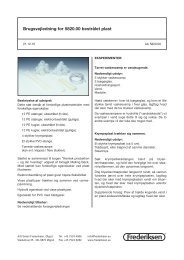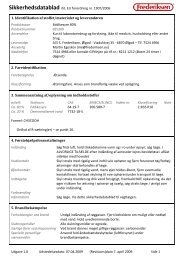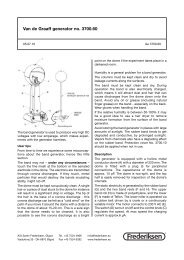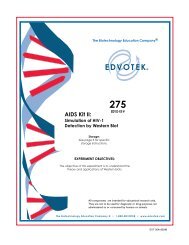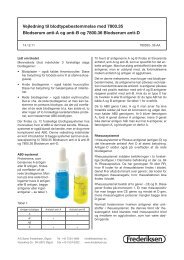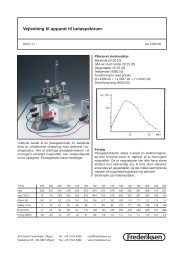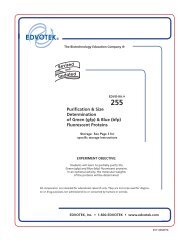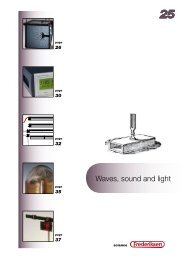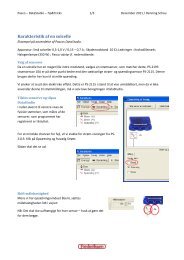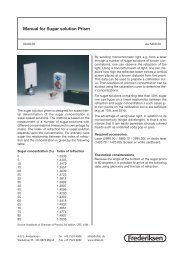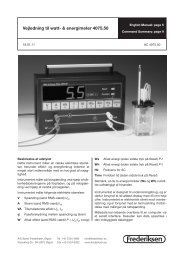Western Blot Analysis - Frederiksen
Western Blot Analysis - Frederiksen
Western Blot Analysis - Frederiksen
You also want an ePaper? Increase the reach of your titles
YUMPU automatically turns print PDFs into web optimized ePapers that Google loves.
The Biotechnology Education Company ®®317EDVO-Kit #<strong>Western</strong> <strong>Blot</strong> <strong>Analysis</strong>Storage:See page 2 for specificstorage instructions.EXPERIMENT OBJECTIVES:The objective of the experiment is for students tounderstand the theory and applications of<strong>Western</strong> <strong>Blot</strong> <strong>Analysis</strong>.All components are intended for educational research only.They are not to be used for diagnostic or drug purposes, noradministered to or consumed by humans or animals.The Biotechnology Education Company ® • 1-800-EDVOTEK • www.edvotek.comEVT 004185AM
2EDVO-Kit # 317<strong>Western</strong> <strong>Blot</strong> <strong>Analysis</strong>Table of ContentsPageExperiment Components 3Experiment Requirements 3Background Information<strong>Western</strong> <strong>Blot</strong> <strong>Analysis</strong> 4Experiment ProceduresExperiment Overview 6Electrophoresis of Proteins 7<strong>Western</strong> <strong>Blot</strong> Procedure 11Study Questions 14Instructor's GuidelinesNotes to the Instructor 15Pre-Lab Preparations 16Idealized Schematic of Results 19Study Questions and Answers 20Material Safety Data Sheets 21EVT 004185AMThe Biotechnology Education Company ® • 1-800-EDVOTEK • www.edvotek.com
EDVO-Kit # 317<strong>Western</strong> <strong>Blot</strong> <strong>Analysis</strong>3Experiment ComponentsThis experiment containsenough reagents for6 lab groups.Enough membrane isprovided to accommodateblotting of three8x10 cm gels.The samples, controls andmarkers are ready forelectrophoresis afterboiling.Components A - I shouldbe stored in therefrigerator. All othercomponents can be storedat room temperature.ContentsStorageA Pre-stained Protein Standard Markers (lyophilized) RefrigeratorB Negative Control (lyophilized) RefrigeratorC BSA high concentration (lyophilized) RefrigeratorD BSA low concentration (lyophilized) RefrigeratorImmunochemical and <strong>Blot</strong>ting ReagentsE Anti-BSA Protein Antibody RefrigeratorF Secondary Antibody Conjugate RefrigeratorG Hydrogen Peroxide, stabilized RefrigeratorH Peroxide Co-substrate RefrigeratorI 10x Blocking Buffer RefrigeratorJ Powdered Milk Room Temp.K 10x PBS Room Temp.• 10x Tris-Glycine-SDS Buffer (Chamber Buffer) Room Temp.• 10x Tris-Glycine Buffer (for transfer buffer) Room Temp.• Practice Gel Loading Solution Room Temp.• Nylon Membrane Room Temp.• Filter Paper Room Temp.• Large Filter Paper Room Temp.RequirementsAll components areintended foreducational researchonly. They are not tobe used fordiagnostic or drugpurposes, noradministered to orconsumed byhumans or animals.No componentshave been preparedfrom human sources.• 12% Denaturing Polyacrylamide gels (3)• Vertical Gel Electrophoresis Apparatus* (Cat. #581) or equivalent• D.C. Power Supply• Shaker Platform (optional)• Burners or Hot Plates• Automatic Pipets with Tips• Microtest (Microcentrifuge) Tubes• Beakers• Pipets• Graduated Cylinders• Plastic Wrap• Scissors• Metric Rulers• Trays or Containers• Several Packs of Paper Towels• Latex or Vinyl Lab Gloves• Safety Goggles• Methanol• Distilled Water* EDVOTEK® Model MV10 (catalog #581) is recommended.EDVOTEK - The Biotechnology Education Company ®1-800-EDVOTEK • www.edvotek.com24-hour FAX: (301) 340-0582 • email: edvotek@aol.comEVT 004185AM
4EDVO-Kit # 317<strong>Western</strong> <strong>Blot</strong> <strong>Analysis</strong><strong>Western</strong> <strong>Blot</strong> <strong>Analysis</strong>Background InformationEnzyme linked immunoadsorbent assay (ELISA) is an important diagnosticimmunochemical method used for the detection of low levels of antigens.A positive reaction in the ELISA requires further, more definitive testing forverification. One reason for this problem is that antibodies sometimesexhibit cross reactivity. For example, it is possible that an individualpossesses IgG molecules that were not raised against a particular virus butbind to the viral antigens. Cross reactivity is usually due to common orrelated sets of epitopes between two different antigens. There are alsoother technical and procedural problems that can give false positives.ELISA testing can only indicate the presence of certain antigens or antibodies.However, immunoblotting can be used to detect several proteinantigens that are viral specific.In <strong>Western</strong> <strong>Blot</strong> <strong>Analysis</strong>, the first step is a denaturing polyacrylamide gelanalysis. Denaturing gel electrophoresis separates proteins based on theirsize. In most cases the protein's native conformation, charge and aminoacid composition do not affect the electrophoretic migration rate in thepresence of saturating SDS (sodium dodecylsulfate). SDS is a detergentwhich consists of a hydrocarbon chain bonded to a highly negativelycharged sulfate group.PROPERTIES OF PROTEINSSDS binds strongly to most proteins and causes them to unfold to a random,rod-like chain and also makes them net negative in charge. Nocovalent bonds are broken in this process. Therefore, the amino acidcomposition and sequence remains the same. Since its specific threedimensionalshape is abolished, the protein no longer possesses biologicalactivity. Proteins that have lost their specific folding patterns and biologicalactivity but have their polypeptide chains remaining intact are calleddenatured. Proteins which contain several polypeptide chains that areassociated only by non-covalent forces, but do not contain denaturingagents such as 2-mercaptoethanol, will be dissociated by SDS into separate,denatured polypeptide chains. Proteins can also contain covalentcrosslinks known as disulfide bonds. These bonds are formed between twocysteine amino acid residues that can be located in the same or differentpolypeptide chains. High concentrations of reducing agents, such as 2-mercaptoethanol, will break disulfide bonds. This allows the SDS to completelydissociate and denature the protein.During electrophoresis, the SDS denatured proteins migrate through thegel towards the positive electrode at a rate that is inversely proportional totheir molecular weight. In other words, the smaller the protein, the faster itmigrates. The molecular weight of the unknown is obtained by thecomparison of its position after electrophoresis to the positions of standardSDS denatured proteins electrophoresed in parallel.EDVOTEK and The Biotechnology Education Company are registered trademarks of EDVOTEK, Inc.Duplication of this document, in conjunction with use of accompanying reagents, is permitted for classroom/laboratory use only. This document, or any part, may not be reproduced or distributed for any other purposewithout the written consent of EDVOTEK, Inc. Copyright © 2000, 2005 EDVOTEK, Inc., all rights reserved.EVT 004185AMThe Biotechnology Education Company ® • 1-800-EDVOTEK • www.edvotek.com
Background InformationEDVO-Kit # 317<strong>Western</strong> <strong>Blot</strong> <strong>Analysis</strong>5<strong>Western</strong> <strong>Blot</strong> <strong>Analysis</strong>WESTERN BLOT ANALYSIS<strong>Western</strong> <strong>Blot</strong> <strong>Analysis</strong> involves the direct transfer of protein bands from apolyacrylamide gel to a charged nylon sheet. Proteins are adsorbed tothe membrane by hydrophobic bonds. After electrophoresis, transfer ofproteins can be done electrophoretically in a specially designed chamber.Transfer can also be accomplished by capillary flow or suction.Protein bands are transfered on the surface of the nylon membrane.Membranes are much stronger and more pliable than gels and canundergo many manipulations without tearing. Total protein transferredcan be visualized by staining the membrane with protein specific dyes.Specific proteins are detected by immunochemical methods.Specific proteins cannot be detected by total protein staining becausethe amount of protein may be too low and due to the banding of otherproteins that may block it from view. For immunological detection theunstained membrane is placed in blocking buffer which contains detergentsand blocking proteins that bind to all unoccupied sites on themembrane. The membrane is then incubated in buffer that containsantibody to one or more of the blotted proteins. The antibody binds tothe adsorbed protein antigen. Subsequent washings will remove excess,unbound antibody. A secondary antibody against the first antibody,linked to an enzyme such as alkaline phosphatase or horseradish peroxidase,is used for detection. The cross-linking of the enzyme to the secondaryantibody is done under conditions that do not appreciably affect theantigen binding specificity, the affinity of the antibody, or the catalyticactivity of the enzyme. The membrane is incubated in a solution of thesecondary antibody where it will bind selectively to the antigen-antibodycomplex and washed to remove excess secondary antibody. In the nextstep, the membrane is incubated in a solution containing phosphatase orperoxidase substrates that yield chromogenic products. Areas containingantigen-antibody conjugates will develop color, depending on thetype of substrate used and product formed.In this experiment, students will use <strong>Western</strong> <strong>Blot</strong> <strong>Analysis</strong> to detect aspecific protein.Duplication of this document, in conjunction with use of accompanying reagents, is permitted for classroom/laboratory use only. This document, or any part, may not be reproduced or distributed for any other purposewithout the written consent of EDVOTEK, Inc. Copyright © 2000, 2005 EDVOTEK, Inc., all rights reserved.EVT 004185AMThe Biotechnology Education Company ® • 1-800-EDVOTEK • www.edvotek.com
6EDVO-Kit # 317<strong>Western</strong> <strong>Blot</strong> <strong>Analysis</strong>Experiment OverviewEXPERIMENT OBJECTIVE:Experiment ProceduresThe objective of this experiment is for students to understand the theoryand applications of <strong>Western</strong> <strong>Blot</strong> <strong>Analysis</strong>.Wear glovesand safetygogglesLABORATORY SAFETYGloves and goggles should be worn routinely throughoutthe experiment as good laboratory practice.Duplication of this document, in conjunction with use of accompanying reagents, is permitted for classroom/laboratory use only. This document, or any part, may not be reproduced or distributed for any other purposewithout the written consent of EDVOTEK, Inc. Copyright © 2000, 2005 EDVOTEK, Inc., all rights reserved.EVT 004185AMThe Biotechnology Education Company ® • 1-800-EDVOTEK • www.edvotek.com
Experiment ProceduresEDVO-Kit # 317<strong>Western</strong> <strong>Blot</strong> <strong>Analysis</strong>7Electrophoresis of ProteinsPREPARING THE POLYACRYLAMIDE GEL FOR ELECTROPHORESISPre-cast Polyacrylamide Gels:If you are using pre-cast polyacrylamide gels, depending upon themanufacturer, they will vary slightly in design. Procedures for their use willbe similar.1. Open the pouch containing the gel cassette with scissors. Removethe cassette and place it on the bench top with the front facing up.Note: The front plate is smaller (shorter) than the back plate.The figure below shows apolyacrylamide gelcassette in the ED-VOTEK® Vertical ElectrophoresisApparatus,Model #MV102. Some cassettes will have tape at the bottom of thefront plate. Remove all of the tape to expose thebottom of the gel to allow electrical contact.Proper Orientation of the Gel in theElectrophoresis UnitBuffer LevelNegative ElectrodeBlack Dot (-)MicropipetwithFine tip1. Place the gel cassette in the electrophoresis unit inthe proper orientation. The proteins samples will notseparate in gels that are not oriented correctly.Follow the directions accompanying the specificapparatus.2. Remove the comb by placing your thumbs on theridges and pushing (pressing) upwards.Sample WellViewing Level(cut out areaon frontsupport panel)3. Add the diluted buffer into the chamber. Thesample wells and the back plate of the gel cassetteshould be submerged under buffer.LongCassettePlatePlatinumwireWell Preparation1. Use a transfer pipet to rinse each well with theelectrophoresis buffer in the chamber.2. Use a syringe or transfer pipet to carefully straightenany wells which may have been distorted duringcomb removal or rinsing.Gel CassetteClipPolyacrylamideGelShort CassettePlateThe gel is now ready for practice gel loading and/or samples.Duplication of this document, in conjunction with use of accompanying reagents, is permitted for classroom/laboratory use only. This document, or any part, may not be reproduced or distributed for any other purposewithout the written consent of EDVOTEK, Inc. Copyright © 2000, 2005 EDVOTEK, Inc., all rights reserved.EVT 004185AMThe Biotechnology Education Company ® • 1-800-EDVOTEK • www.edvotek.com
8EDVO-Kit # 317<strong>Western</strong> <strong>Blot</strong> <strong>Analysis</strong>Electrophoresis of ProteinsPRACTICE GEL LOADINGExperiment Procedures1. Place a fresh tip on themicropipet. Remove 20 µlof practice gel loadingsolution.Wear glovesand safetygoggles2. Place the lower portion ofthe pipet tip below thesurface of the electrodebuffer, directly over a sample well. The tip should be at an anglepointed towards the well. The tip should be partially against the backplate of the gel cassette but the tip opening should be over thesample well, as illustrated on page 7.Do not try and jam the pipet tip in between the plates of the gelcassette.3. Eject all the sample by steadily pressing down on the plunger of theautomatic pipet.Do not release the plunger before all the sample is ejected. Prematurerelease of the plunger will cause buffer to mix with sample in themicropipet tip. Release the pipet plunger after the sample has beendelivered and the pipet tip is out of the buffer.4. Before loading protein samples for the actual experiment, the practicegel loading solution must be removed from the sample wells.Do this by filling a transfer pipet with buffer and squirting a stream intothe sample wells. This will displace the practice gel loading solution,which will be diluted into the buffer and will not interfere with theexperiment.Duplication of this document, in conjunction with use of accompanying reagents, is permitted for classroom/laboratory use only. This document, or any part, may not be reproduced or distributed for any other purposewithout the written consent of EDVOTEK, Inc. Copyright © 2000, 2005 EDVOTEK, Inc., all rights reserved.EVT 004185AMThe Biotechnology Education Company ® • 1-800-EDVOTEK • www.edvotek.com
Experiment ProceduresEDVO-Kit # 317<strong>Western</strong> <strong>Blot</strong> <strong>Analysis</strong>9Electrophoresis of ProteinsPREPARATION OF SAMPLES FORELECTROPHORESISProtein Denaturation (Day One)Samples may have been reconstituted byyour instructor. If not, you will need to performthis step before the samples are loadedon the gel.Quick Reference:The heating (Steps 1-3)disrupts aggregates ofdenatured proteins.Denatured proteins tendto form super-molecularaggregates andinsoluble particulates.Denatured proteins tend to form supermolecularaggregates and insoluble particulates. Heating disruptsmetastable aggregates of denatured proteins.1. Bring a beaker of water, covered with aluminum foil, to a boil.Remove from heat.2. Resuspend the lyophilized proteins (Tubes A-D) in 125 µl distilledwater. Vortex well.3. Make sure the sample tubes A through D are tightly capped andthawed. Label the tops of the tubes. Tap the tubes until all thesample is at the bottom. The bottom of the tubes should bepushed through the foil and immersed in the hot water for 10minutes. The tubes should be kept suspended by the foil.4. Proceed to loading samples while they are still warm.Loading SamplesLoad 20 µl each of the samples in tubes A - Dinto wells 1 - 4 in consecutive order. The othergroup sharing the gel should load 20 µl eachof the samples in tubes A - D into wells 7 - 10in consecutive order.Quick Reference:Use an automaticmicropipet to deliversamples. The amountof sample that should beloaded is 20 µl.Duplication of this document, in conjunction with use of accompanying reagents, is permitted for classroom/laboratory use only. This document, or any part, may not be reproduced or distributed for any other purposewithout the written consent of EDVOTEK, Inc. Copyright © 2000, 2005 EDVOTEK, Inc., all rights reserved.EVT 004185AMThe Biotechnology Education Company ® • 1-800-EDVOTEK • www.edvotek.com
10EDVO-Kit # 317<strong>Western</strong> <strong>Blot</strong> <strong>Analysis</strong>Electrophoresis of ProteinsRUNNING THE GELExperiment Procedures1. After the samples are loaded, carefully snap the cover all the waydown onto the electrode terminals. On EDVOTEK® electrophoresisunits, the black plug in the cover should be on the terminal with theblack dot.2. Insert the plug of the black wire into the black input of the powersupply (negative input). Insert the plug of the red wire into the redinput of the power supply (positive input).3. Set the power supply at the required voltage and run the electrophoresisfor the length of time as determined by your instructor. Whenthe current is flowing, you should see bubbles forming on the electrodes.The sudsing is due to the SDS in the buffer.4. After the electrophoresis is finished, turn off power, unplug the unit,disconnect the leads and remove the cover.5. Remove the gel cassette from the electrophoresis apparatus and blotoff excess buffer with a paper towel.6. Lay the cassette down and remove the front plate by placing aspatula or finger at the top edge, near the sample wells, and lifting itaway from the larger back plate. In most cases, the gel will stay onthe back plate. If it partially pulls away with the front plate, let it fallonto the back plate.7. Carefully place the gel intransfer buffer and soak for10 minutes.Time and VoltageRecommended TimeVoltsMinimum Optimal125 45 min 60 min70 60 min 1.5 hrsDuplication of this document, in conjunction with use of accompanying reagents, is permitted for classroom/laboratory use only. This document, or any part, may not be reproduced or distributed for any other purposewithout the written consent of EDVOTEK, Inc. Copyright © 2000, 2005 EDVOTEK, Inc., all rights reserved.EVT 004185AMThe Biotechnology Education Company ® • 1-800-EDVOTEK • www.edvotek.com
Experiment ProceduresEDVO-Kit # 317<strong>Western</strong> <strong>Blot</strong> <strong>Analysis</strong>11<strong>Western</strong> <strong>Blot</strong> ProcedureRemember!BLOTTING PROCEDURE1. Cut two pieces of blotting paper and one nylon membrane to fitgel.Wear gloves whenhandling nylonmembrane to avoidtransferring oil from yourskin which will interferewith the protein transfer.2. Cut wick to width of gel and length to overhang from edge of trayto within 1/8" edge of tray bottom (Figure 2).3. Pre-soak wick, blotting paper, and membrane in transfer buffer (20mM Tris-Cl pH 8.0, 150 mM glycine, 20% methanol) for 5-10 minutes.4. Soak gel for 10 minutes in transfer buffer.5. Place larger gel plate on top of a container of dimensions ofapproximately 16 cm x 9 cm x 4 cm (L x W x D). Add transferbuffer to the tray and place presoaked wick onto gel plate suchthat ends are submerged in 2 cm of transfer buffer (see Figure 1).Transfer BufferLarge gelplateGelTracking dyeFigure 1:Top view of the blot transfer assembly.WickTray0.7-1.0 kgFigure 2:Side view of the blot transferassembly.Glass PlatePaper Towels<strong>Blot</strong>ting PaperLarge Gel PlateContainerTransfer BufferMembraneGelWickDuplication of this document, in conjunction with use of accompanying reagents, is permitted for classroom/laboratory use only. This document, or any part, may not be reproduced or distributed for any other purposewithout the written consent of EDVOTEK, Inc. Copyright © 2000, 2005 EDVOTEK, Inc., all rights reserved.EVT 004185AMThe Biotechnology Education Company ® • 1-800-EDVOTEK • www.edvotek.com
12EDVO-Kit # 317<strong>Western</strong> <strong>Blot</strong> <strong>Analysis</strong><strong>Western</strong> <strong>Blot</strong> Procedure6. Place gel flat on top of wick. Smooth over top of gel to remove airbubbles.Experiment Procedures7. Place nylon membrane on top of gel. Smooth over top to remove airbubbles.8. Place the two pieces of blotting paper (from step 1) on top of themembrane.9. Place a 6 cm stack of paper towels on top of blotting paper. Finally,place a 1 kg weight on top of stack to complete assembly, as shownin Figure 2.10. Allow transfer to take place overnight (12-15 hrs).STOPPING POINTDuplication of this document, in conjunction with use of accompanying reagents, is permitted for classroom/laboratory use only. This document, or any part, may not be reproduced or distributed for any other purposewithout the written consent of EDVOTEK, Inc. Copyright © 2000, 2005 EDVOTEK, Inc., all rights reserved.EVT 004185AMThe Biotechnology Education Company ® • 1-800-EDVOTEK • www.edvotek.com
Experiment ProceduresEDVO-Kit # 317<strong>Western</strong> <strong>Blot</strong> <strong>Analysis</strong>13<strong>Western</strong> <strong>Blot</strong> ProcedureIMMUNODETECTION1. Dismantle stack above membrane.Carefully remove membrane fromgel with spatula. Verify that transferoccurred by the presence ofprestained protein markers onmembrane.2. Carefully cut membrane in half.Each group will then proceedindependently.Useful Hint!The lid from amicropipet rack(200µl size) workswell for a tray to incubatethe membrane.3. Transfer membrane to a small tray or small sealable plastic bagcontaining 10ml blocking solution (membrane should be submerged)and occasionally agitate for 5 minutes.4. Discard the blocking solution. Place the membrane in 10ml freshblocking solution containing the primary antibody at a dilution of1:1000. Place on a rotating or shaking platform for one hour at roomtemperature.5. Discard antibody-containing solution and wash membrane for5 minutes in 10 ml blocking buffer.6. Discard blocking wash buffer and repeat washing with 10 ml freshblocking buffer.7. Incubate with 10 ml peroxidase-conjugated secondary antibody(1:2000) in blocking buffer for one hour, with shaking.NOTE:Substrate isprepared by yourinstructor justprior to use.8. Discard solution and wash membrane for five minutes with PBS.Repeat wash.9. Add substrate solution which has been prepared by your instructor.Place membrane in 12 ml substrate solution and incubate until colordevelopment is observed.10. Wash membrane with water and then air dry. Alternatively, you canblot the edge of the membrane onto a paper towel.11. Compare the size of the samples containing the various concentrationsrelative to the protein standard markers.Duplication of this document, in conjunction with use of accompanying reagents, is permitted for classroom/laboratory use only. This document, or any part, may not be reproduced or distributed for any other purposewithout the written consent of EDVOTEK, Inc. Copyright © 2000, 2005 EDVOTEK, Inc., all rights reserved.EVT 004185AMThe Biotechnology Education Company ® • 1-800-EDVOTEK • www.edvotek.com
14EDVO-Kit # 317<strong>Western</strong> <strong>Blot</strong> <strong>Analysis</strong>Experiment Results and Study QuestionsLABORATORY NOTEBOOK RECORDINGS:Experiment ProceduresAddress and record the following in your laboratory notebook or on aseparate worksheet.Before starting the experiment:• Write a hypothesis that reflects the experiment.• Predict experimental outcomes.During the Experiment:• Record (draw) your observations, or photograph the results.Following the Experiment:• Formulate an explanation from the results.• Determine what could be changed in the experiment if theexperiment were repeated.• Write a hypothesis that would reflect this change.STUDY QUESTIONSAnswer the following study questions in your laboratory notebook or on aseparate worksheet.1. Why are the electrophoretically fractionated proteins transferred to amembrane for immunological detection?2. Why is the membrane blocked before incubation with milk?3. Would higher or lower percentage gels favor transfer to a membrane?Would larger or smaller proteins transfer better?4. What is the purpose of the negative and positive controls?Duplication of this document, in conjunction with use of accompanying reagents, is permitted for classroom/laboratory use only. This document, or any part, may not be reproduced or distributed for any other purposewithout the written consent of EDVOTEK, Inc. Copyright © 2000, 2005 EDVOTEK, Inc., all rights reserved.EVT 004185AMThe Biotechnology Education Company ® • 1-800-EDVOTEK • www.edvotek.com
EDVO-Kit # 317<strong>Western</strong> <strong>Blot</strong> <strong>Analysis</strong>15Notes to the InstructorThis experiment requires three 12% Denaturing Polyacrylamide Gels to beshared by the 6 student groups. Each group requires 4 sample wells.Class size, length of laboratory sessions, and availability of equipment arefactors which must be considered in the planning and the implementationof this experiment with your students. These guidelines can beadapted to fit your specific set of circumstances.Online Orderingnow availablewww.edvotek.comVisit our web site forinformation aboutEDVOTEK®'scompleteline of experiments forbiotechnology andbiology education.If you do not find the answers toyour questions in this section, avariety of resources are continuouslybeing added to the EDVOTEK® website. In addition, Technical Service isavailable from 9:00 am to 6:00 pm,Eastern time zone. Call for helpfrom our knowledgeable technicalstaff at 1-800-EDVOTEK (1-800-338-6835).Technical ServiceDepartmentInstructor's GuideM o nEDVO-TECH-Fri9SERVICE1-800-EDVOTEK(1-800-338-6835)am- 6E TpmMon - Fri9:00 am to 6:00 pm ETFAX: (301) 340-0582web: www.edvotek.comemail: edvotek@aol.comPlease have the following information:• The experiment number and title• Kit Lot number on box or tube• The literature version number(in lower right corner)• Approximate purchase dateDuplication of this document, in conjunction with use of accompanying reagents, is permitted for classroom/laboratory use only. This document, or any part, may not be reproduced or distributed for any other purposewithout the written consent of EDVOTEK, Inc. Copyright © 2005 EDVOTEK, Inc., all rights reserved.EVT 004185AMThe Biotechnology Education Company ® • 1-800-EDVOTEK • www.edvotek.com
16EDVO-Kit # 317<strong>Western</strong> <strong>Blot</strong> <strong>Analysis</strong>PreLab PreparationsInstructor's GuideTRANSFER BUFFER (REQUIRED FIRST DAY)1. To 700 ml of distilled water, add 100 ml of 10X Tris-Glycine concentrate.2. Add 200 ml of 95 - 100% methanol. Mix. If the final volume is less than1 liter, bring up to volume with distilled water. Mix. Keep tightlycovered.ELECTROPHORESIS BUFFER, TRIS-GLYCINE-SDS BUFFER1. Add 1 part EDVOTEK® 10X buffer to every 9 parts distilled water.2. Make enough 1X buffer for the 3 electrophoresis units (2 liters for threeEDVOTEK® units).PREPARATION OF MEMBRANES(Any time before the lab - required first day)Wear rinsed and dried lab gloves. Powders from gloves will interfere withthe procedure.1. Keep both upper and lower protective cover sheets around themembranes and make sure the cover sheets and membrane are allaligned. Keep the membrane covered this way during all the followingsteps.2. If you are using gels that are smaller or larger than the 8 x 10 cm, youmust adjust the dimensions of your membrane squares accordingly.You may also have to alter the sizes of the filter paper and towels thestudents prepare. Larger gels may necessitate less groups.3. Cut three membranes for the 6 groups to share.SPECIFIC REQUIREMENT FOR THIS EXPERIMENTThis experiment requires three 12% Denaturing Polyacrylamide Gels to beshared by the 6 student groups. Each group requires 4 sample wells. Theprotein standard marker and components B, C, and D must be reconstituted.Duplication of this document, in conjunction with use of accompanying reagents, is permitted for classroom/laboratory use only. This document, or any part, may not be reproduced or distributed for any other purposewithout the written consent of EDVOTEK, Inc. Copyright © 2005 EDVOTEK, Inc., all rights reserved.EVT 004185AMThe Biotechnology Education Company ® • 1-800-EDVOTEK • www.edvotek.com
EDVO-Kit # 317<strong>Western</strong> <strong>Blot</strong> <strong>Analysis</strong>17Pre-Lab PreparationsWear SafetyGoggles andGlovesRECONSTITION OF LYOPHILIZED PROTEINS1. Add 125 µl distilled water to each of the tubes, A-D. Vortex each tubefor 30 seconds each, or until completely dissolved.2. Wear safety goggles and bring a beaker of water, covered withaluminum foil, to a boil. Remove from heat.3. Make sure the tube lids are securely fastened. Suspend the tubes in aboiling water bath for 10 minutes.4. Remove and have students load gels while proteins are still warm Tapor briefly microcentrifuge to get condensate at the top of the tubesback into the sample.This experiment contains practice gel loading solution. If you areunfamiliar with gel electrophoresis, it is suggested that you practiceloading the sample wells before performing the actual experiment.Refer to instructions entitled "Practice Gel Loading Instructions".Instructor's GuideTime and VoltageVoltsTime125 45 - 60 min.70 1 - 1.5 hoursUseful Hint!The blocking buffer willlikely precipitate duringstorage. Warm at 37°C for5-10 minutes or until theprecipitate has dissolved.ELECTROPHORESIS TIME AND VOLTAGEYour time requirements will dictate the voltage and the length of time it willtake for your samples to separate by electrophoresis. Approximaterecommended times are listed in the table to the left.Run the gel until the bromophenol blue tracking dye is near the bottomedge of the gel.PREPARATION OF REAGENTS FOR IMMUNODETECTION(On the day of the lab - required second day)1. Dilute 10x blocking buffer by adding 540 ml distilled water. The blockingbuffer will likely precipitate during storage. Warm at 37°C for 5-10minutes or until the precipitate has dissolved.2. Prepare complete blocking buffer by adding the powdered milk (J) to600 ml diluted blocking buffer (I).3. Dilute the Anti-BSA Antibody 1:1000 by adding the entire contents oftube E to 65 ml complete blocking buffer. Rinse tube E to ensure youhave all of the Anti-BSA. Refrigerate.4. Dilute the secondary antibody 1:2000 by adding the entire contents oftube F to 65 ml complete blocking buffer. Rinse tube F to ensure youhave all of the secondary antibody. Refrigerate.5. Dilute the 10x PBS solution by adding the contents of bottle K (30 ml) to270 ml distilled water. Dispense 25 ml for each group.Duplication of this document, in conjunction with use of accompanying reagents, is permitted for classroom/laboratory use only. This document, or any part, may not be reproduced or distributed for any other purposewithout the written consent of EDVOTEK, Inc. Copyright © 2005 EDVOTEK, Inc., all rights reserved.EVT 004185AMThe Biotechnology Education Company ® • 1-800-EDVOTEK • www.edvotek.com
18EDVO-Kit # 317<strong>Western</strong> <strong>Blot</strong> <strong>Analysis</strong>Pre-Lab PreparationsInstructor's GuideCaution!Do not use Methanolwith acrylic materials.Methanol will destroyacrylic.PREPARATION OF PEROXIDASE SUBSTRATE DURING THE LABEXPERIMENTPrepare 15 - 30 minutes before the last incubation:1. Dispense 68 ml of diluted phosphatebuffered saline (PBS) to aclean flask or beaker.2. Add peroxide co-substrate (H) tothe 68 ml of PBS. Cap and mixthoroughly by shaking and /orvortexing. There is usually undissolvedmaterial remaining.Quick Reference:The substrate is prepared forthe peroxidase enzyme, whichis attached to the anti-IgGperoxidase conjugate(secondary antibody).3. Then add 7.5 ml of Hydrogenperoxide (G). Cap and mix.4. Dispense 12 ml of the peroxidasesubstrate for each group.Prepare the substrate 15-30minutes before studentsrequire it for plate development(last incubation).INDIVIDUAL GROUP REAGENT REQUIREMENTS:First Day (Reagents for Two Groups)• Boiled components A - D (aliquots if desired)• Practice gel loading solution (optional)• Diluted electrophoresis buffer• 100 ml of diluted transfer buffer• 1 nylon membrane• 5 filter paper pieces• Wick• Paper towels and plastic wrap• Small plastic boxes for soaking membranes and gels• Pipet• 0.7 - 1.0 kg weight• Small dish (less than width of gel) for transferSecond Day (Individual Groups)• Approximately 60 ml complete blocking buffer• 25 ml diluted PBS• 70 ml distilled water• 10 ml diluted secondary antibody conjugate• 10 ml diluted Anti-BSA Antibody• 12 ml prepared substrateDuplication of this document, in conjunction with use of accompanying reagents, is permitted for classroom/laboratory use only. This document, or any part, may not be reproduced or distributed for any other purposewithout the written consent of EDVOTEK, Inc. Copyright © 2005 EDVOTEK, Inc., all rights reserved.EVT 004185AMThe Biotechnology Education Company ® • 1-800-EDVOTEK • www.edvotek.com
EDVO-Kit # 317<strong>Western</strong> <strong>Blot</strong> <strong>Analysis</strong>19Idealized Schematic of ResultsThe positive control and patient sample should show an immunoreactiveband. The immunoreactive bands roughly correspond to a molecularweight of 67 KD. The negative control will not have immunoreactivebands.LaneContents1 A Standard Protein Markers2 B Negative Control3 C BSA low concentration4 D BSA high concentrationInstructor's GuideBSA aggregates may be present(cross-react with antibody)94,00067,00043,00030,00020,10014,400BSA also usedin standardmarkersDuplication of this document, in conjunction with use of accompanying reagents, is permitted for classroom/laboratory use only. This document, or any part, may not be reproduced or distributed for any other purposewithout the written consent of EDVOTEK, Inc. Copyright © 2005 EDVOTEK, Inc., all rights reserved.EVT 004185AMThe Biotechnology Education Company ® • 1-800-EDVOTEK • www.edvotek.com
20EDVO-Kit # 317<strong>Western</strong> <strong>Blot</strong> <strong>Analysis</strong>Study Questions and AnswersInstructor's Guide1. Why are the electrophoretically fractionated proteins transferred to amembrane for immunological detection?After transfer, the proteins remain irreversibly bound to the membrane,which can then be probed with antibodies to detect specific proteins.This detection would not be possible while the proteins remain in thegel, as diffusion out of the gel would occur. Furthermore, repeatedmanipulation of a gel is much more difficult than manipulation of amembrane.2. Why is the membrane blocked before incubation with milk?The membrane is blocked with milk to saturate nonspecific bindingsites on the membrane. Otherwise, antibody molecules could bind tothese same nonspecific sites and yield a false positive signal.3. Would higher or lower percentage gels favor transfer to a membrane?Would larger or smaller proteins transfer better?Lower percentage gels would favor transfer to a membrane, due totheir larger pore sizes. Similarly, smaller proteins would transfer moreeasily, due to their better migration through pores.4. What is the purpose of the negative and positive controls?The purpose of the negative control is to ensure that the antibody isspecific only for the antigen to which it was raised. The purpose of thepositive control is to ensure no technical problems occur during theexperiment.Duplication of this document, in conjunction with use of accompanying reagents, is permitted for classroom/laboratory use only. This document, or any part, may not be reproduced or distributed for any other purposewithout the written consent of EDVOTEK, Inc. Copyright © 2005 EDVOTEK, Inc., all rights reserved.EVT 004185AMThe Biotechnology Education Company ® • 1-800-EDVOTEK • www.edvotek.com
IDENTITY (As Used on Label and List)Hydrogen Peroxide, StabilizedSection IManufacturer's NameEDVOTEK, Inc.Address (Number, Street, City, State, Zip Code)®14676 Rothgeb DriveRockville, MD 20850Special Fire Fighting ProceduresUnusual Fire and Explosion HazardsMaterial Safety Data SheetMay be used to comply with OSHA's Hazard CommunicationStandard. 29 CFR 1910.1200 Standard must be consulted forspecific requirements.Note: Blank spaces are not permitted. If any item is notapplicable, or no information is available, the space mustbe marked to indicate that.Emergency Telephone Number(301) 251-5990Telephone Number for information(301) 251-5990Date PreparedSignature of Preparer (optional)Section II - Hazardous Ingredients/Identify InformationHazardous Components [SpecificOther LimitsChemical Identity; Common Name(s)] OSHA PEL ACGIH TLV Recommended % (Optional)Hydrogen peroxide, H2O2 No data 1.2%CAS # 7722-84-1Section III - Physical/Chemical CharacteristicsBoiling PointNo data Specific Gravity (H 0 = 1)2Vapor Pressure (mm Hg.) at 30°C22.3 Melting PointVapor Density (AIR = 1)1Evaporation Rate(Butyl Acetate = 1)Solubility in WaterSolubleAppearance and Odor Colorless liquid, no odorSection IV - Physical/Chemical Characteristics N.D. = No dataFlash Point (Method Used)Flammable Limits LELNo dataN.D.Extinguishing MediaWatersprayWear SCBA and protective clothing to prevent contact with skin and eyes.IDENTITY (As Used on Label and List)Peroxide Co-substrateSection IManufacturer's NameEDVOTEK, Inc.Address (Number, Street, City, State, Zip Code)®14676 Rothgeb DriveRockville, MD 2085009-17-20021.110Strong oxidizer, contact with other material may cause fire.Container explosion may occur under fire conditions.Material Safety Data SheetMay be used to comply with OSHA's Hazard CommunicationStandard. 29 CFR 1910.1200 Standard must be consulted forspecific requirements.No dataNo dataUELN.D.Note: Blank spaces are not permitted. If any item is notapplicable, or no information is available, the space mustbe marked to indicate that.Emergency Telephone Number(301) 251-5990Telephone Number for information(301) 251-5990Date PreparedSignature of Preparer (optional)Section II - Hazardous Ingredients/Identify InformationHazardous Components [SpecificOther LimitsChemical Identity; Common Name(s)] OSHA PEL ACGIH TLV Recommended % (Optional)5-aminosalicylic acid-----------------------------No data------------------------------CAS# 89-57-6Section III - Physical/Chemical CharacteristicsBoiling PointNo data Specific Gravity (H 0 = 1)2No dataVapor Pressure (mm Hg.)No data Melting Point280°CVapor Density (AIR = 1)No data Evaporation Rate(Butyl Acetate = 1)No dataSolubility in WaterSolubleAppearance and Odor Light tan-gray powder with clumpsSection IV - Physical/Chemical Characteristics N.D. = No dataFlash Point (Method Used)Flammable Limits LEL UELNo dataN.D. N.D.Extinguishing MediaWater spray, carbon dioxide, dry chemical powder or appropriate foamSpecial Fire Fighting Procedures09-18-2002Wear protective clothing and SCBA to prevent contact with skin & eyesSection V - Reactivity DataStabilityUnstableStableConditions to AvoidHazardousMay OccurConditions to AvoidPolymerizationWill Not Occur XNoneSection VI - Health Hazard DataRoute(s) of Entry: Inhalation?Yes Skin? Yes Ingestion? YesHealth Hazards (Acute and Chronic) Acute: Irritates mucous membranes upperrespiratory tract, eyes, skinChronic: May have mutagenic affectCarcinogenicity:No dataNTP? IARC Monographs? OSHA Regulation?Signs and Symptoms of Exposure Inhalation: burning sensation, coughing, wheezing, laryngitis,shortness of breath, headache, nausea. Irritation.Medical Conditions Generally Aggravated by Exposure No dataEmergency First Aid Procedures Ingestion: Wash mouth out with water. Contact physicianEyes: Flush with water Inhalation: Move to fresh air Skin: Flush with waterSection VII - Precautions for Safe Handling and UseSteps to be Taken in case Material is Released for SpilledWaste Disposal Method Cautiously acidify to pH2 with Sulfuric acid. Add a 50% excess of aqueoussodium bisulfate with stirring (heat generated). If no heat is evident, cautiously add until heat is liberated.Precautions to be Taken in Handling and StoringObserve federal, state, and local lawsOther PrecautionsSection VIII - Control MeasuresRespiratory Protection (Specify Type)Excessive heatIncompatibilityStrong acide, aluminum, steelHazardous Decomposition or Byproducts Toxic oxides of phosphorousMop up with absorbent material and dispose of properlyStore away from incompatibilitiesVentilation Local Exhaust NoSpecialMechanical (General) NoOtherProtective Gloves RubberEye ProtectionXNIOSH/MSHA approvedNoChemical fume hoodSafety gogglesOther Protective Clothing or Equipment Rubber bootsWork/Hygienic Practices Avoid inhalation. Keep away from incompatibilities and combustible material.Section V - Reactivity DataStabilityUnstableConditions to AvoidStable XIncompatiblesIncompatibilityAcids, acid chlorides, acid anhydrides, chloroformates, strong oxidizing agentsHazardous Decomposition or Byproducts Nitrogen oxides, carbon monoxide, and carbon dioxideHazardousMay OccurConditions to AvoidPolymerizationWill Not Occur XSection VI - Health Hazard DataRoute(s) of Entry: Inhalation?Yes Skin? Yes Ingestion? YesHealth Hazards (Acute and Chronic)Irritating to mucous membranes and upper respiratory tractCarcinogenicity: NTP? IARC Monographs? OSHA Regulation?---------------------------------No data------------------------------------Signs and Symptoms of ExposureEye and skin irritationMedical Conditions Generally Aggravated by Exposure No dataEmergency First Aid Procedures Ingestion: Rinse mouth with waterEyes/Skin: Flush with waterInhalation: Move to fresh airSection VII - Precautions for Safe Handling and UseSteps to be Taken in case Material is Released for Spilled Wear suitable protective clothing. Sweep upand place in container for disposal. Avoid raising dust. Ventilate area.Waste Disposal Method Mix with combustible solvent and burn in chemical incinerator with afterburnerand scrubber. Observe federal, state, and local laws.Precautions to be Taken in Handling and StoringOther PrecautionsSection VIII - Control MeasuresRespiratory Protection (Specify Type)Avoid contact or raising dust.NoneVentilation Local Exhaust NoSpecialMechanical (General) YesOtherProtective Gloves Chemical resistantEye ProtectionNoneNoneChemical safety gogglesUnusual Fire and Explosion HazardsEmits toxic fumes under fire conditionsOther Protective Clothing or EquipmentWork/Hygienic PracticesLab coatAvoid contact
IDENTITY (As Used on Label and List)10x PBSSection IManufacturer's NameEDVOTEK, Inc.Address (Number, Street, City, State, Zip Code)®14676 Rothgeb DriveRockville, MD 20850Material Safety Data SheetMay be used to comply with OSHA's Hazard CommunicationStandard. 29 CFR 1910.1200 Standard must be consulted forspecific requirements.Section II - Hazardous Ingredients/Identify InformationHazardous Components [SpecificChemical Identity; Common Name(s)] OSHA PEL ACGIH TLVN/A BlendNote: Blank spaces are not permitted. If any item is notapplicable, or no information is available, the space mustbe marked to indicate that.Emergency Telephone Number(301) 251-5990Telephone Number for information(301) 251-5990Date Prepared09-19-2002Signature of Preparer (optional)Other LimitsRecommendedSection III - Physical/Chemical CharacteristicsBoiling Point100°C Specific Gravity (H 0 = 1)2Vapor Pressure (mm Hg.)No dataMelting PointVapor Density (AIR = 1)Evaporation Rate(Butyl Acetate = 1)No dataSolubility in WatersolubleAppearance and Odorcolorless liquidSection IV - Physical/Chemical CharacteristicsFlash Point (Method Used)Flammable Limits LELNoncombustibleExtinguishing MediaUse extinquishing media appropriate to surrounding fireSpecial Fire Fighting Procedures% (Optional)1.017No dataNo dataWear SCBA and protective clothing to prevent contact with skin and eyesUnusual Fire and Explosion HazardsEmits toxic fumes under fire conditionsIDENTITY (As Used on Label and List)Antibody Samples/317Section IManufacturer's NameEDVOTEK, Inc.Address (Number, Street, City, State, Zip Code)®14676 Rothgeb DriveRockville, MD 20850Material Safety Data SheetMay be used to comply with OSHA's Hazard CommunicationStandard. 29 CFR 1910.1200 Standard must be consulted forspecific requirements.Section II - Hazardous Ingredients/Identify InformationHazardous Components [SpecificChemical Identity; Common Name(s)] OSHA PEL ACGIH TLVCAS # 139-33-3CAS # 26628-22-8Very diluteUELNote: Blank spaces are not permitted. If any item is notapplicable, or no information is available, the space mustbe marked to indicate that.Emergency Telephone Number(301) 251-5990Telephone Number for information(301) 251-5990Date Prepared09-15-2002Signature of Preparer (optional)Other LimitsRecommendedSection III - Physical/Chemical CharacteristicsBoiling PointNo data Specific Gravity (H 0 = 1)2Vapor Pressure (mm Hg.)No data Melting PointVapor Density (AIR = 1)No data Evaporation Rate(Butyl Acetate = 1)Solubility in WaterSolubleAppearance and OdorClear liquid, no odorSection IV - Physical/Chemical CharacteristicsFlash Point (Method Used)Flammable Limits LELNo dataExtinguishing MediaDry chemical, carbon dioxide, halon, water spray or standard foam% (Optional)No dataNo dataNo dataSpecial Fire Fighting ProceduresMove container from fire area if possible. Dike fire control water for later disposalUnusual Fire and Explosion HazardsThermal decomposition products may include toxic and hazardous oxides of carbon,nitrogen, and sodium.UELSection V - Reactivity DataStabilityIncompatibilityUnstableStableConditions to AvoidHazardous Decomposition or ByproductsNature of decomposition products not knownHazardousMay OccurConditions to AvoidPolymerizationWill Not OccurSection VI - Health Hazard DataRoute(s) of Entry: Inhalation? Skin?Ingestion?Yes Yes YesHealth Hazards (Acute and Chronic) Cause eye & skin irritation, material is irritating to mucous membranesand upper respiratory tract. The toxocological properties have not been thoroughly investigated.Carcinogenicity: NTP? IARC Monographs? OSHA Regulation?Signs and Symptoms of ExposureMedical Conditions Generally Aggravated by ExposureEmergency First Aid ProceduresSwallowed - wash out mouth with water provided person is conscious.Skin/eye contact - flush with water Inhalation - remove to fresh airSection VII - Precautions for Safe Handling and UseSteps to be Taken in case Material is Released for SpilledWear respirator, chemical safety goggles, rubber boots and heavy rubber gloves, sweep up, place in a bagand hold for waste disposal.Waste Disposal MethodFor small quantities - cautiosly add to a large stirred excess of water. Adjust pH to neutralPrecautions to be Taken in Handling and StoringWear appropriate NIOSH/MSHA approved respirator, chemical resistant gloves, safety gogglessafety shower and eye bath.Other PrecautionsStrong acidsSection VIII - Control MeasuresRespiratory Protection (Specify Type) NIOSH/MSHA approved respiratorVentilation Local Exhaust N/ASpecialN/AMechanical (General) N/A Other N/AProtective GlovesYesEye Protection YesOther Protective Clothing or EquipmentWork/Hygienic Practices Do not ingest. Avoid contact with skin, eyes and clothing. Wash thoroughlyafter handling.Section V - Reactivity DataStabilityUnstableConditions to AvoidStable X Excessive heat, sparks or open flame, protein denaturantsIncompatibilityAcids, aluminum, metals, oxidizers (strong)Hazardous Decomposition or ByproductsThermal decomposition products of toxic & hazardous oxides of Carbon and nitrogenHazardousMay OccurConditions to AvoidPolymerizationWill Not Occur XSection VI - Health Hazard DataRoute(s) of Entry: Inhalation? Skin?Ingestion?Yes Yes YesHealth Hazards (Acute and Chronic) Moderately toxic by ingestion. Systematic toxicity may result.May chelate lead, magnesium, zinc, trace metals if present in intestine. Sensitivity reactions-anaphylactic shockCarcinogenicity:NoneNTP?No dataIARC Monographs?No dataOSHA Regulation?No dataSigns and Symptoms of ExposureMucous membrane irritation, eye/skin irritation, irritating to gastrointestinal system.MedicalRenalConditionsor heart disease,GenerallypotassiumAggravateddeficiency,by Exposureinsulin-dependent, diabetes, seizures or intracranial lesionsEmergency First Aid ProceduresTreat symptomatically and supportivelySection VII - Precautions for Safe Handling and UseSteps to be Taken in case Material is Released for SpilledMop up with absorptive material. Containerize to dispose of properly.Waste Disposal MethodObserve all federal, state and local regulationsPrecautions to be Taken in Handling and StoringStore away from strong oxidizers or heat. Avoid eye/skin contact.Other NONE PrecautionsSection VIII - Control MeasuresRespiratory Protection (Specify Type)Chemical cartridge respirator with full facepiece and organic vapor cartridgeVentilation Local Exhaust NoSpecial NoneMechanical (General) Gen. dilution vent sys. Other NoneProtective GlovesYesEye ProtectionSplash proof gogglesOther Protective Clothing or EquipmentImpervious clothing to prevent contact.Work/Hygienic PracticesEmergency eye wash should be available



